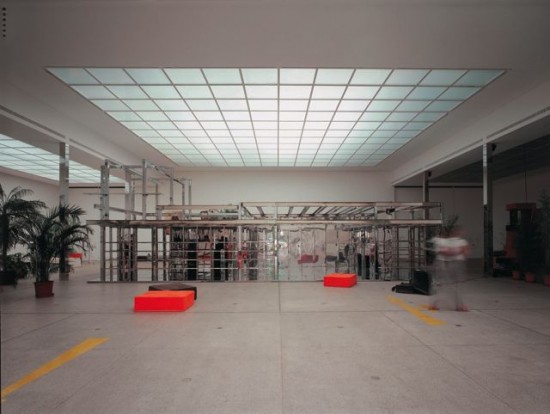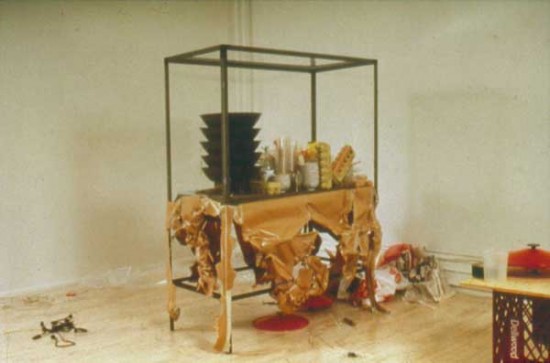II. Time as a measurement of the imagination

Installation view, Vienna Secession, 2002. All images: Courtesy Rirkrit Tiravanija and Gallery Side 2, Tokyo.
ART iT: Returning to the idea of sculpture as a reproductive medium, what happens in the case of 1:1 recreation, as with the replica you made of your New York apartment, and the replica you made of the Schindler House at the Vienna Secession in 2002?
RT: Those structures are being used as a reference. They’re being used because they mean something to me in the sense that they have a certain kind of functionality, which gives other people a chance to use them as well, and then from within that use, some kind of meaning emerges.
I pick certain things because I find that they can provide a way to reach certain kinds of understanding. For example, Schindler House was about the structure and how the structure works and how you inhabit it, but it’s also about the person, Schindler himself, who was really interesting as an architect.
ART iT: Both Lewis Carroll and Jorge Luis Borges were interested in the idea of the 1:1 map, which of course would cover everything it sets out to represent, and this is why I mentioned the idea of transparent sculpture, because at 1:1 you lose sight of the work’s sculpturalness as you experience it.
RT: I think that’s very interesting. Hans Ulrich Obrist is currently working on a map book, and did a map conference. Maps are about going through things in different ways. I think the idea of 1:1 brings with it a lot of possibilities.
I always like it when you can’t photograph the work, either because you can’t see it, because you don’t know what you’re looking for, or because it’s too big to fit in the frame, so essentially you have to be there for the scale and distance to make sense.
ART iT: So everyone is producing the image in their own heads as they experience the work?
RT: Yes. For my exhibition at Musée d’Art Moderne de la Ville de Paris in 2005, “A Retrospective (tomorrow is another fine day),” there were no actual works on display. It was about everyone seeing and experiencing them through their own mental images. Even when we are looking – and we are looking all the time – there are things we don’t see unless we consciously think about them. That’s very important in art. That’s why somebody is able to be an artist and somebody else not. I think it has to do with how one perceives things and then is able to make others experience it.
ART iT: With “Retrospective,” what was the process of deciding that, rather than replicating the works, you would just do the spaces with the sound?
RT: Well, that’s what I do – I sit around and think about things like that. A retrospective exhibition is interesting and useful in the sense that it allows for people to see works that they might not have seen, or might have only seen through images. But it would be like Disneyland if you put the apartment next to the Schindler House next to something else – although maybe that would be interesting too, and you could have a little train that everybody rides as they go through the show.
Basically I was working with two possibilities: one possibility would have been to pursue something like reenactments, similar to what Marina Abramovic did for her show at MoMA in 2010, and a topic she and I have had many discussions about. But then you have to build the reenactment problem into the situation – and it has to be a problem, not a solution. People have to realize, “Oh, I’m only looking at a tableau, and not having the actual experience.” So that would be like a theatre, which maybe is what I would do if I have another retrospective: visitors would sit in a theatre and then the different works would be presented on stage with actors.
Then the other possibility was to create a completely new experience using the existing works as a platform for what essentially would be a whole new work.

Untitled 1990 (pad thai).
ART iT: Then, as scenarios, the individual exhibitions create material that could be used in other combinations at other times?
RT: Sure. I’m always rethinking and relooking because, to begin with, I’m not making things that have a definite beginning and end. I’m not sure where it starts or ends, and you always have to be watching, and things happen in a certain time. When I did the first cooking piece, I realized immediately that it was a mistake, and then with the second cooking piece I realized what the mistakes were. That’s why there is always a series of things, and they shift for different reasons, because I’m always rethinking what it is or could be.
With the first cooking piece, I was working with this idea of reanimation: you go to museums and you see a beautiful pot or bowl and you look at it as an object, but there’s a huge gap between why those things are there – they are made beautifully – and the reality that it was a rice bowl for eating rice. I questioned that distance because in the Western structure there is an aesthetic value but in my structure the value is in using the object. So I took the museum objects out of the vitrine and I used them, but because I didn’t use them fully, I was still making a display. The curry was boiling in the pot, but people were just looking at it, and that’s when I realized that they have to eat the curry, and then when people started to eat, more people came, and then I couldn’t cook fast enough so other people started to help. I mean, I never perform, I’m just doing what I have to do, and usually I’m doing it very slow, or late, so then you’re still working on it and then you realize there’s no need to start or finish by a certain time. Who set those rules? Who said that the lights have to be on? All those things are something that once you are aware of you can say no to, or say yes to because you want to point at something specific.
ART iT: You also did that with your rock opera, Ramakien (2006), keeping the theatre lights up even after everyone was seated and the performance had started.
RT: Yes. It looked like the orchestra and cast were still rehearsing and the spectators didn’t know what was going on. They thought that it hadn’t started but it had already started. But you’re in this format with the stage and the seating, and you want everyone to be involved, so all you have to do is leave the lights on, because people are used to just sitting in the dark.
I basically approach it through my own experience of what I’ve seen myself, and play off those things. People have their watches on and they have the time structure, or they want to go for dinner right after the event but maybe the event never ends. It keeps going. Then they have to decide whether they want to stay or go, and then if they go, maybe they think to themselves that really good things happened after they left, while the people who stay might be thinking that they should have gone to dinner. All those things are part of the human mentality. Doubt is one of the most important parts of our consciousness. We don’t believe everything because we’re able to think around it. We’re built to analyze things and question things and go around them because we have doubt.
ART iT: So do you conceive or the gallery space or theatrical space – communal space – as a sponge for absorbing all these individual dramas that are created through doubt in the people who enter those situations?
RT: I would say that is important in terms of what the work has to offer. Rather than being antagonistic, it’s about you having to decide, and you being responsible for yourself, because you made certain decisions. You can have a good or bad experience, but it’s important that you decide for yourself.
ART iT: Then do you view your works as 1:1 replicas of entire social situations, and not just, say, a 1:1 replica of your apartment?
RT: It’s hard to say. Human relations are very complex. In terms of scale and the reality of being in it, maybe yes. But in terms of how it works, it’s hard to say. It’s a platform that you decide to act on as an audience member, and then what happens with that, I really don’t know. I think that’s always been important for me – to not know – because if I did know, then everybody would end up moving in the same direction and doing the same thing and coming away with the same experience. The unknown and the potential it has are really important for me.
Rirkrit Tiravanija: On Exactitude in Science
